Assessing Cultural Ecosystem Services in Sponge City Infrastructure: A Systematic Review and Framework Proposal
Abstract
1. Introduction
2. Methods
2.1. Data Collection
2.2. Study Selection Criteria
- Published between 2013 and April 2025 to capture the emergence and development of CES research in relation to China’s sponge city initiative, formally launched in 2015;
- Written in English;
- Published as peer-reviewed journal articles reporting original empirical research;
- Focused on the evaluation of CES;
- Conducted in China and specifically focused on green or blue infrastructure associated with sponge city initiatives (e.g., urban parks, wetlands, blue–green corridors);
- Provided empirical data through case studies, surveys, participatory mapping, or other forms of primary data collection.
- Were conducted in regions other than China;
- Were conceptual or theoretical papers, editorials, or policy commentaries lacking empirical analysis;
- Focused exclusively on provisioning services (e.g., food, water supply) or regulating services (e.g., flood control) without incorporating any CES components;
- Were limited to hydrological or engineering aspects without discussing cultural values;
- Were non-peer-reviewed materials, including conference abstracts, dissertations, technical reports, and other non-peer-reviewed publications.
2.3. Identification of Paper Categorization
2.3.1. Geographic Location and Type of the Study
- (1)
- Blue and Green Areas: Dou et al. [24], focused on blue areas (e.g., water and wetlands) and green areas (e.g., forests, street trees, cropland, and grasslands), which are among the measures employed by sponge cities in addressing stormwater management.
- (2)
- Urban Green Spaces: Mao et al. [25] studied roadside parks, residential green areas, and natural woodlands, highlighting their dual role in both stormwater regulation and cultural ecosystem services, particularly in providing recreational opportunities.
- (3)
2.3.2. CES Categories
2.3.3. CES Indicators
2.3.4. Classification of CES Assessment Methods
- (1)
- Market-based (e.g., market prices);
- (2)
- Observation-based (e.g., direct observation, document analysis, social media data);
- (3)
- Stated preferences (e.g., interviews and questionnaires);
- (4)
- Expert-based methods (e.g., Delphi technique); and
- (5)
- Participatory and technology-assisted approaches (e.g., PGIS, PPGIS, VEP, and Virtual Reality).
3. Results
3.1. Study Selection and Publication Trends
3.2. Geographic Distribution and Thematic Focus of CES Studies
3.3. CES Category
3.4. CES Assessment Methodology
3.5. CES Assessment Indicators
4. Discussion
4.1. The Number of Articles Related to This Topic
4.2. Geographic Location and Research Focus
4.3. Categories Assessment of CES
4.4. Assessment Methods
4.5. CES Evaluation Indicators Challenges in the Application
4.6. Toward a Localized CES Evaluation Framework for SPI: Structure and Implications
5. Conclusions
Supplementary Materials
Author Contributions
Funding
Acknowledgments
Conflicts of Interest
References
- Xiong, L.; Yan, L.; Du, T.; Yan, P.; Li, L.; Xu, W. Impacts of Climate Change on Urban Extreme Rainfall and Drainage Infrastructure Performance: A Case Study in Wuhan City, China. Irrig. Drain. 2019, 68, 152–164. [Google Scholar] [CrossRef]
- Trenberth, K.E. Changes in Precipitation with Climate Change. Clim. Res. 2011, 47, 123–138. [Google Scholar] [CrossRef]
- Shastri, H.; Ghosh, S.; Paul, S.; Shafizadeh-Moghadam, H.; Helbich, M.; Karmakar, S. Future Urban Rainfall Projections Considering the Impacts of Climate Change and Urbanization with Statistical–Dynamical Integrated Approach. Clim. Dyn. 2019, 52, 6033–6051. [Google Scholar] [CrossRef]
- Khodadad, M.; Aguilar-Barajas, I.; Khan, A.Z. Green Infrastructure for Urban Flood Resilience: A Review of Recent Literature on Bibliometrics, Methodologies, and Typologies. Water 2023, 15, 523. [Google Scholar] [CrossRef]
- Qi, Y.; Chan, F.K.S.; Thorne, C.; O’Donnell, E.; Quagliolo, C.; Comino, E.; Pezzoli, A.; Li, L.; Griffiths, J.; Sang, Y.; et al. Addressing Challenges of Urban Water Management in Chinese Sponge Cities via Nature-Based Solutions. Water 2020, 12, 2788. [Google Scholar] [CrossRef]
- Xia, J.; Zhang, Y.; Xiong, L.; He, S.; Wang, L.; Yu, Z. Opportunities and Challenges of the Sponge City Construction Related to Urban Water Issues in China. Sci. China Earth Sci. 2017, 60, 652–658. [Google Scholar] [CrossRef]
- Liu, D. China’s Sponge Cities to Soak up Rainwater. Nature 2016, 537, 307. [Google Scholar] [CrossRef]
- Chan, F.K.S.; Griffiths, J.A.; Higgitt, D.; Xu, S.; Zhu, F.; Tang, Y.-T.; Xu, Y.; Thorne, C.R. “Sponge City” in China—A Breakthrough of Planning and Flood Risk Management in the Urban Context. Land Use Policy 2018, 76, 772–778. [Google Scholar] [CrossRef]
- Guo, Z.; Zhang, X.; Winston, R.; Smith, J.; Yang, Y.; Tao, S.; Liu, H. A Holistic Analysis of Chinese Sponge City Cases by Region: Using PLS-SEM Models to Understand Key Factors Impacting LID Performance. J. Hydrol. 2024, 637, 131405. [Google Scholar] [CrossRef]
- Tang, Y.T.; Chan, F.K.S.; O’Donnell, E.C.; Griffiths, J.; Lau, L.; Higgitt, D.L.; Thorne, C.R. Aligning Ancient and Modern Approaches to Sustainable Urban Water Management in China: Ningbo as a “Blue-Green City” in the “Sponge City” Campaign. J. Flood Risk Manag. 2018, 11, e12451. [Google Scholar] [CrossRef]
- Wang, H.; Mei, C.; Liu, J.; Shao, W. A New Strategy for Integrated Urban Water Management in China: Sponge City. Sci. China Technol. Sci. 2018, 61, 317–329. [Google Scholar] [CrossRef]
- Ministry of Ecology and Environment of the People’s Republic of China. 14th Five Year Plan for Environmental Health Work; Ministry of Ecology and Environment of the People’s Republic of China: Beijing, China, 2022.
- Ministry of Ecology and Environment of the People’s Republic of China. 14th Five-Year Plan and 2035 Long-Term Objectives. 2021. Available online: https://climate-laws.org/document/14th-five-year-plan_0496 (accessed on 24 May 2025).
- Satz, D.; Gould, R.K.; Chan, K.M.A.; Guerry, A.; Norton, B.; Satterfield, T.; Halpern, B.S.; Levine, J.; Woodside, U.; Hannahs, N.; et al. The Challenges of Incorporating Cultural Ecosystem Services into Environmental Assessment. Ambio 2013, 42, 675–684. [Google Scholar] [CrossRef] [PubMed]
- Dang, H.; Li, J. Supply-Demand Relationship and Spatial Flow of Urban Cultural Ecosystem Services: The Case of Shenzhen, China. J. Clean. Prod. 2023, 423, 138765. [Google Scholar] [CrossRef]
- Quevedo, J.M.D.; Kohsaka, R. A Systematic Review of Cultural Ecosystem Services of Blue Carbon Ecosystems: Trends, Gaps, and Challenges in Asia and Beyond. Mar. Policy 2024, 159, 105898. [Google Scholar] [CrossRef]
- Taguchi, V.; Weiss, P.; Gulliver, J.; Klein, M.; Hozalski, R.; Baker, L.; Finlay, J.; Keeler, B.; Nieber, J. It Is Not Easy Being Green: Recognizing Unintended Consequences of Green Stormwater Infrastructure. Water 2020, 12, 522. [Google Scholar] [CrossRef]
- Andersson, E.; Tengö, M.; McPhearson, T.; Kremer, P. Cultural Ecosystem Services as a Gateway for Improving Urban Sustainability. Ecosyst. Serv. 2015, 12, 165–168. [Google Scholar] [CrossRef]
- Wen, L.; Li, B.; Peng, Y.; Zhou, Y.; Weng, A.; Jin, Y.; Cai, G.; Lin, Y.; Chen, B. Exploring the Evolution of Coupled Natural-Cultural Ecosystem Services and Their Geographically Scaled Driven Modeling in a Coastal City of Southeast China. J. Environ. Manag. 2024, 361, 121265. [Google Scholar] [CrossRef]
- Jiang, W. Ecosystem Services Research in China: A Critical Review. Ecosyst. Serv. 2017, 26, 10–16. [Google Scholar] [CrossRef]
- Yang, L.; Cao, K. Cultural Ecosystem Services Research Progress and Future Prospects: A Review. Sustainability 2022, 14, 11845. [Google Scholar] [CrossRef]
- Pascua, P.; McMillen, H.; Ticktin, T.; Vaughan, M.; Winter, K.B. Beyond Services: A Process and Framework to Incorporate Cultural, Genealogical, Place-Based, and Indigenous Relationships in Ecosystem Service Assessments. Ecosyst. Serv. 2017, 26, 465–475. [Google Scholar] [CrossRef]
- Stokowski, P.A. Languages of Place and Discourses of Power: Constructing New Senses of Place. J. Leis. Res. 2002, 34, 368–382. [Google Scholar] [CrossRef]
- Dou, Y.; Zhen, L.; De Groot, R.; Du, B.; Yu, X. Assessing the Importance of Cultural Ecosystem Services in Urban Areas of Beijing Municipality. Ecosyst. Serv. 2017, 24, 79–90. [Google Scholar] [CrossRef]
- Mao, Q.; Wang, L.; Guo, Q.; Li, Y.; Liu, M.; Xu, G. Evaluating Cultural Ecosystem Services of Urban Residential Green Spaces from the Perspective of Residents’ Satisfaction with Green Space. Front. Public Health 2020, 8, 226. [Google Scholar] [CrossRef]
- Panduro, T.E.; Veie, K.L. Classification and Valuation of Urban Green Spaces—A Hedonic House Price Valuation. Landsc. Urban Plan. 2013, 120, 119–128. [Google Scholar] [CrossRef]
- Bell, S.; Montarzino, A.; Travlou, P. Mapping Research Priorities for Green and Public Urban Space in the UK. Urban For. Urban Green. 2007, 6, 103–115. [Google Scholar] [CrossRef]
- Scholte, S.S.; Van Teeffelen, A.J.; Verburg, P.H. Integrating Socio-Cultural Perspectives into Ecosystem Service Valuation: A Review of Concepts and Methods. Ecol. Econ. 2015, 114, 67–78. [Google Scholar] [CrossRef]
- Márquez, L.A.M.; Rezende, E.C.N.; Machado, K.B.; do Nascimento, E.L.M.; Castro, J.D.B.; Nabout, J.C. Trends in Valuation Approaches for Cultural Ecosystem Services: A Systematic Literature Review. Ecosyst. Serv. 2023, 64, 101572. [Google Scholar] [CrossRef]
- Christie, M.; Fazey, I.; Cooper, R.; Hyde, T.; Kenter, J.O. An Evaluation of Monetary and Non-Monetary Techniques for Assessing the Importance of Biodiversity and Ecosystem Services to People in Countries with Developing Economies. Ecol. Econ. 2012, 83, 67–78. [Google Scholar] [CrossRef]
- Hirons, M.; Comberti, C.; Dunford, R. Valuing Cultural Ecosystem Services. Annu. Rev. Environ. Resour. 2016, 41, 545–574. [Google Scholar] [CrossRef]
- Jim, C.Y. Green-Space Preservation and Allocation for Sustainable Greening of Compact Cities. Cities 2004, 21, 311–320. [Google Scholar] [CrossRef]
- Haase, D.; Larondelle, N.; Andersson, E.; Artmann, M.; Borgström, S.; Breuste, J.; Gomez-Baggethun, E.; Gren, Å.; Hamstead, Z.; Hansen, R.; et al. A Quantitative Review of Urban Ecosystem Service Assessments: Concepts, Models, and Implementation. Ambio 2014, 43, 413–433. [Google Scholar] [CrossRef]
- Ministry of Housing and Urban-Rural Development of China. Technical Guide for Sponge City Construction (Updated Pilot Version); Government of China: Beijing, China, 2022.
- State Council of the People’s Republic of China. The 14th Five-Year Plan for National Economic and Social Development of the People’s Republic of China (2021–2025); Government of China: Beijing, China, 2021.
- Ministry of Ecology and Environment of China. The 14th Five-Year Plan for Ecological and Environmental Protection (2021); Government of China: Beijing, China, 2021.
- Ministry of Natural Resources of the People’s Republic of China. National Territorial Spatial Planning Outline of China (2020–2035); Government of China: Beijing, China, 2020.
- Neidig, J.; Anguelovski, I.; Lliso, B.; Pascual, U. Pluralizing Environmental Values for Urban Planning: How to Uncover the Diversity of Imaginaries about Socio-natures from Vitoria-Gasteiz (Basque Country, Spain). People Nat. 2023, 5, 1262–1283. [Google Scholar] [CrossRef]
- Ma, Y.; Jiang, Y. Mainstreaming the Framework of Ecosystem Services to Enhance China’s Policy Implementation for Sponge City Development. Sustain. Dev. 2023, 31, 2291–2306. [Google Scholar] [CrossRef]
- Raymond, C.; Breil, M.; Nita, M.; Kabisch, N.; de Bel, M.; Enzi, V.; Frantzeskaki, N.; Geneletti, G.; Lovinger, L.; Cardinaletti, M.; et al. An Impact Evaluation Framework to Support Planning and Evaluation of Nature-Based Solutions Projects; Centre for Ecology and Hydrology: Wallingford, UK, 2017. [Google Scholar]
- Andersson, E.; Barthel, S.; Borgström, S.; Colding, J.; Elmqvist, T.; Folke, C.; Gren, Å. Reconnecting Cities to the Biosphere: Stewardship of Green Infrastructure and Urban Ecosystem Services. Ambio 2014, 43, 445–453. [Google Scholar] [CrossRef] [PubMed]
- Xu, J.; Huang, G.; Ye, Y.; Liu, Z. Spatial-Temporally and Industrially Heterogeneous Effects of New Infrastructure Construction on Fostering Emerging Industries in Chinese Cities. Heliyon 2024, 10, e23774. [Google Scholar] [CrossRef]
- Yin, D.; Chen, Y.; Jia, H.; Wang, Q.; Chen, Z.; Xu, C.; Li, Q.; Wang, W.; Yang, Y.; Fu, G.; et al. Sponge City Practice in China: A Review of Construction, Assessment, Operational and Maintenance. J. Clean. Prod. 2021, 280, 124963. [Google Scholar] [CrossRef]
- Tate, C.; Wang, R.; Akaraci, S.; Burns, C.; Garcia, L.; Clarke, M.; Hunter, R. The Contribution of Urban Green and Blue Spaces to the United Nation’s Sustainable Development Goals: An Evidence Gap Map. Cities 2024, 145, 104706. [Google Scholar] [CrossRef]
- Valente De Macedo, L.S.; Barda Picavet, M.E.; Puppim De Oliveira, J.A.; Shih, W.-Y. Urban Green and Blue Infrastructure: A Critical Analysis of Research on Developing Countries. J. Clean. Prod. 2021, 313, 127898. [Google Scholar] [CrossRef]
- Dong, Q.; Zeng, P.; Long, X.; Peng, M.; Tian, T.; Che, Y. An Improved Accessibility Index to Effectively Assess Urban Park Allocation: Based on Working and Residential Situations. Cities 2024, 145, 104736. [Google Scholar] [CrossRef]
- Veerkamp, C.J.; Schipper, A.M.; Hedlund, K.; Lazarova, T.; Nordin, A.; Hanson, H.I. A Review of Studies Assessing Ecosystem Services Provided by Urban Green and Blue Infrastructure. Ecosyst. Serv. 2021, 52, 101367. [Google Scholar] [CrossRef]
- Wang, S.; Palazzo, E. Sponge City and Social Equity: Impact Assessment of Urban Stormwater Management in Baicheng City, China. Urban Clim. 2021, 37, 100829. [Google Scholar] [CrossRef]
- Zhao, J. Research Hotspots and Trends in Chinese Academic Abstracts (2000–2022)—A Visualization Analysis Based on CiteSpace. J. Educ. Educ. Res. 2024, 10, 232–239. [Google Scholar] [CrossRef]
- Zhang, L.; Leydesdorff, L. The Scientometric Measurement of Interdisciplinarity and Diversity in Research Portfolios of Chinese Universities. J. Data Inf. Sci. 2021, 6, 13–35. [Google Scholar] [CrossRef]
- Wang, T. Cultural Diversity and Educational Policy in Chinese Society. City Divers. 2020, 1, 1926. [Google Scholar] [CrossRef]
- Yuan, X. Citespace-Based Knowledge Mapping Analysis of China’s Cultural Heritage Institutions and Regulations. Front. Bus. Econ. Manag. 2023, 10, 352–358. [Google Scholar] [CrossRef]
- Lin, H.; Hong, X.-C.; Wen, C.; Hu, F. The Historical Sensing of Urban Forest Based on the Indicators of CES and Landscape Categories: A Case of Kushan Scenic Area in CHINA. Ecol. Indic. 2024, 166, 112440. [Google Scholar] [CrossRef]
- Pan, Y.; Qu, Y. Cultural Ecosystem Services in Land Use/Land Cover Change: A Literature Review and Prospects for Future Research. Land 2024, 13, 2027. [Google Scholar] [CrossRef]
- Cheng, X.; Van Damme, S.V.; Uyttenhove, P. Assessing the Impact of Park Renovations on Cultural Ecosystem Services. Land 2022, 11, 610. [Google Scholar] [CrossRef]
- Liu, J.; Han, H.; Chen, Z. Study on Practice Framework and Evaluation Indicator System of Landsense Design for the Enhancement of Cultural Ecosystem Services in Historical Blocks. Landsc. Archit. Front. 2024, 12, 62. [Google Scholar] [CrossRef]
- Jones, R.; Cox, S.; Jones, T. Place Meaning and Place Attachment. In International Encyclopedia of Geography; Richardson, D., Castree, N., Goodchild, M.F., Kobayashi, A., Liu, W., Marston, R.A., Eds.; Wiley: Hoboken, NJ, USA, 2022; pp. 1–6. ISBN 978-0-470-65963-2. [Google Scholar]
- Liao, X. Spiritually Cultural Differences between China and the West Manifested by Material Cultures—Human-Oriented Philosophy versus Harmonious Coexistence of Man and Nature. Open J. Soc. Sci. 2023, 11, 305–313. [Google Scholar] [CrossRef]
- Cushing, D.F.; Miller, E. Place Attachment Theory. In Creating Great Places; Routledge: New York, NY, USA, 2019; pp. 67–79. ISBN 978-0-429-28963-7. [Google Scholar]
- Blicharska, M.; Smithers, R.J.; Hedblom, M.; Hedenås, H.; Mikusiński, G.; Pedersen, E.; Sandström, P.; Svensson, J. Shades of Grey Challenge Practical Application of the Cultural Ecosystem Services Concept. Ecosyst. Serv. 2017, 23, 55–70. [Google Scholar] [CrossRef]
- Jiang, W.; Marggraf, R. Making Intangibles Tangible: Identifying Manifestations of Cultural Ecosystem Services in a Cultural Landscape. Land 2021, 11, 26. [Google Scholar] [CrossRef]
- Nie, X.; Huang, C.; Wang, H. A New Method to Classify Cultural Ecosystem Services and Visualize Their Economic Value: A Case Study of Guilin, a Famous Tourist Destination in China. Ecosyst. Serv. 2025, 72, 101708. [Google Scholar] [CrossRef]
- Xu, H.; Zhao, G.; Fagerholm, N.; Primdahl, J.; Plieninger, T. Participatory Mapping of Cultural Ecosystem Services for Landscape Corridor Planning: A Case Study of the Silk Roads Corridor in Zhangye, China. J. Environ. Manag. 2020, 264, 110458. [Google Scholar] [CrossRef]
- Raymond, C.M.; Brown, G.; Weber, D. The Measurement of Place Attachment: Personal, Community, and Environmental Connections. J. Environ. Psychol. 2010, 30, 422–434. [Google Scholar] [CrossRef]
- Henshaw, V. Urban Smellscapes: Understanding and Designing City Smell Environments; Routledge: New York, NY, USA, 2013. [Google Scholar]
- Dai, P.; Zhang, S.; Chen, Z.; Gong, Y.; Hou, H. Perceptions of Cultural Ecosystem Services in Urban Parks Based on Social Network Data. Sustainability 2019, 11, 5386. [Google Scholar] [CrossRef]
- Poorthuis, A.; Chen, Q.; Zook, M. A Nationwide Dataset of De-Identified Activity Spaces Derived from Geotagged Social Media Data. Environ. Plan. B Urban Anal. City Sci. 2024, 51, 2264–2275. [Google Scholar] [CrossRef]
- Klain, S.C.; Chan, K.M.A. Navigating Coastal Values: Participatory Mapping of Ecosystem Services for Spatial Planning. Ecol. Econ. 2012, 82, 104–113. [Google Scholar] [CrossRef]
- Chivulescu, S.; Hapa, M.; Pitar, D.; Lorenţ, A.; Marmureanu, L.; Leca, S.; Radu, R.; Cazacu, R.; Dobre, A.C.; Pascu, I.S.; et al. Integrating Monetary and Non-Monetary Valuation for Ecosystem Services in Piatra Craiului National Park, Southern Carpathians: A Comprehensive Approach to Sustainability and Conservation. Front. For. Glob. Change 2024, 7, 1280793. [Google Scholar] [CrossRef]
- Costanza, R.; d’Arge, R.; De Groot, R.; Farber, S.; Grasso, M.; Hannon, B.; Limburg, K.; Naeem, S.; O’Neill, R.V.; Paruelo, J.; et al. The Value of the World’s Ecosystem Services and Natural Capital. Nature 1997, 387, 253–260. [Google Scholar] [CrossRef]
- De Groot, R.; Brander, L.; Van Der Ploeg, S.; Costanza, R.; Bernard, F.; Braat, L.; Christie, M.; Crossman, N.; Ghermandi, A.; Hein, L. Global Estimates of the Value of Ecosystems and Their Services in Monetary Units. Ecosyst. Serv. 2012, 1, 50–61. [Google Scholar] [CrossRef]
- Wright, W.C.C.; Eppink, F.V.; Greenhalgh, S. Are Ecosystem Service Studies Presenting the Right Information for Decision Making? Ecosyst. Serv. 2017, 25, 128–139. [Google Scholar] [CrossRef]
- Tian, T.; Sun, L.; Peng, S.; Sun, F.; Che, Y. Understanding the Process from Perception to Cultural Ecosystem Services Assessment by Comparing Valuation Methods. Urban For. Urban Green. 2021, 57, 126945. [Google Scholar] [CrossRef]
- Song, L.; Wu, M.; Wu, Y.; Xu, X.; Xie, C. Research on the Evaluation of Cultural Ecosystem Services in Zhengzhou Urban Parks Based on Public Perceptions. Sustainability 2023, 15, 11964. [Google Scholar] [CrossRef]
- Tandarić, N.; Ives, C.; Watkins, C. Can We Plan for Urban Cultural Ecosystem Services? J. Urban Ecol. 2020, 6, juaa016. [Google Scholar] [CrossRef]
- Chan, K.M.; Gould, R.K.; Pascual, U. Editorial Overview: Relational Values: What Are They, and What’s the Fuss about? Curr. Opin. Environ. Sustain. 2018, 35, A1–A7. [Google Scholar] [CrossRef]
- Fish, R.; Church, A.; Winter, M. Conceptualising Cultural Ecosystem Services: A Novel Framework for Research and Critical Engagement. Ecosyst. Serv. 2016, 21, 208–217. [Google Scholar] [CrossRef]
- Daniel, T.C.; Muhar, A.; Arnberger, A.; Aznar, O.; Boyd, J.W.; Chan, K.M.A.; Costanza, R.; Elmqvist, T.; Flint, C.G.; Gobster, P.H.; et al. Contributions of Cultural Services to the Ecosystem Services Agenda. Proc. Natl. Acad. Sci. USA 2012, 109, 8812–8819. [Google Scholar] [CrossRef]
- Milcu, A.I.; Hanspach, J.; Abson, D.; Fischer, J. Cultural Ecosystem Services: A Literature Review and Prospects for Future Research. Ecol. Soc. 2013, 18, art44. [Google Scholar] [CrossRef]
- Chan, K.M.A.; Guerry, A.D.; Balvanera, P.; Klain, S.; Satterfield, T.; Basurto, X.; Bostrom, A.; Chuenpagdee, R.; Gould, R.; Halpern, B.S.; et al. Where Are Cultural and Social in Ecosystem Services? A Framework for Constructive Engagement. BioScience 2012, 62, 744–756. [Google Scholar] [CrossRef]
- Raymond, C.M.; Singh, G.G.; Benessaiah, K.; Bernhardt, J.R.; Levine, J.; Nelson, H.; Turner, N.J.; Norton, B.; Tam, J.; Chan, K.M.A. Ecosystem Services and Beyond: Using Multiple Metaphors to Understand Human–Environment Relationships. BioScience 2013, 63, 536–546. [Google Scholar] [CrossRef]
- IPBES. Methodological Assessment Regarding the Diverse Conceptualization of Multiple Values of Nature and Its Benefits; Intergovernmental Science-Policy Platform on Biodiversity and Ecosystem Services: Bonn, Germany, 2022. [Google Scholar]
- Millennium Ecosystem Assessment (MEA). Ecosystems and Human Well-Being; Island Press: Washington, DC, USA, 2005; Volume 5. [Google Scholar]
- Raymond, C.M.; Frantzeskaki, N.; Kabisch, N.; Berry, P.; Breil, M.; Nita, M.R.; Geneletti, D.; Calfapietra, C. A Framework for Assessing and Implementing the Co-Benefits of Nature-Based Solutions in Urban Areas. Environ. Sci. Policy 2017, 77, 15–24. [Google Scholar] [CrossRef]
- Plieninger, T.; Dijks, S.; Oteros-Rozas, E.; Bieling, C. Assessing, Mapping, and Quantifying Cultural Ecosystem Services at Community Level. Land Use Policy 2013, 33, 118–129. [Google Scholar] [CrossRef]
- Tengberg, A.; Fredholm, S.; Eliasson, I.; Knez, I.; Saltzman, K.; Wetterberg, O. Cultural Ecosystem Services Provided by Landscapes: Assessment of Heritage Values and Identity. Ecosyst. Serv. 2012, 2, 14–26. [Google Scholar] [CrossRef]
- Hernández-Morcillo, M.; Plieninger, T.; Bieling, C. An Empirical Review of Cultural Ecosystem Service Indicators. Ecol. Indic. 2013, 29, 434–444. [Google Scholar] [CrossRef]

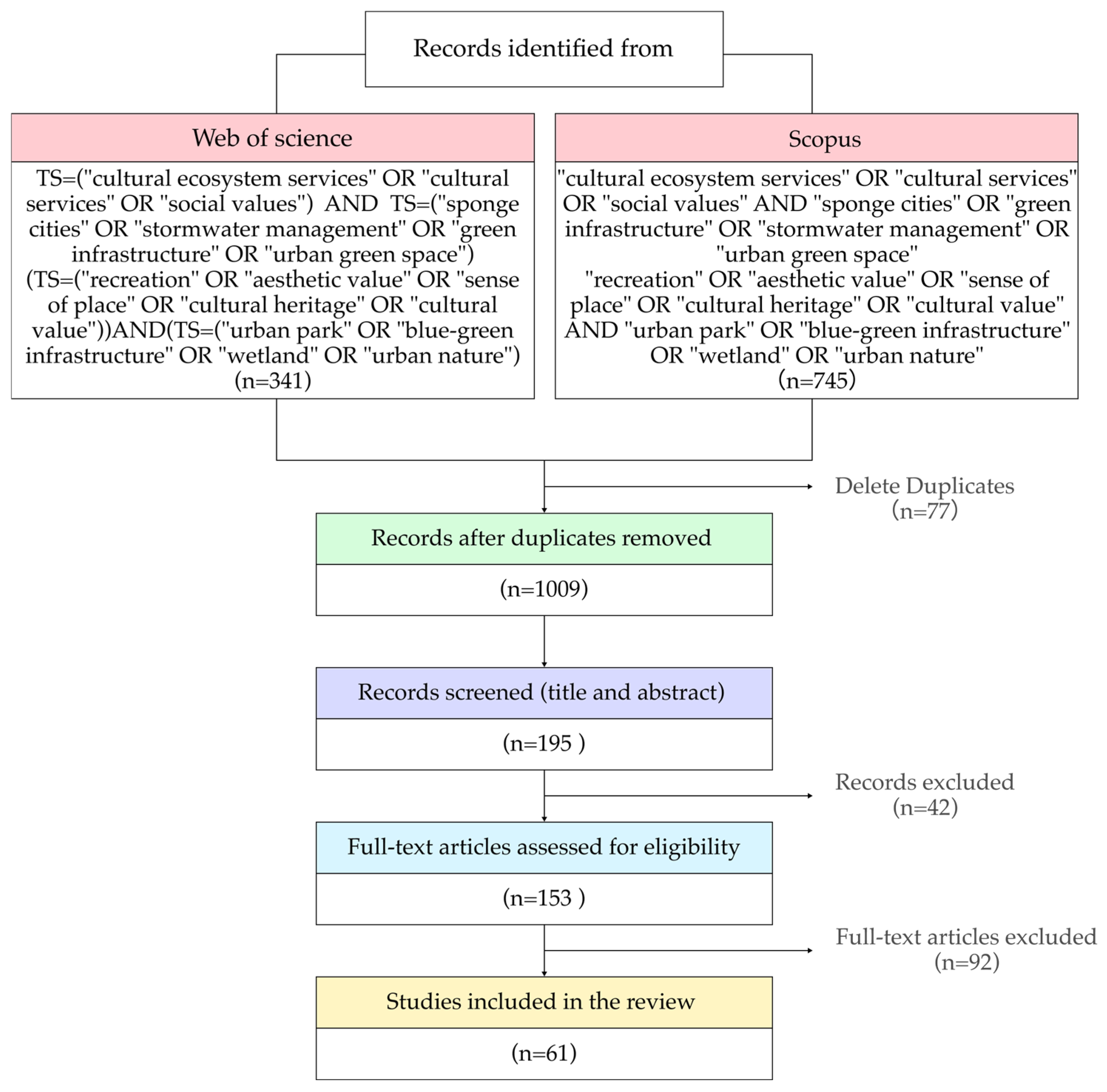
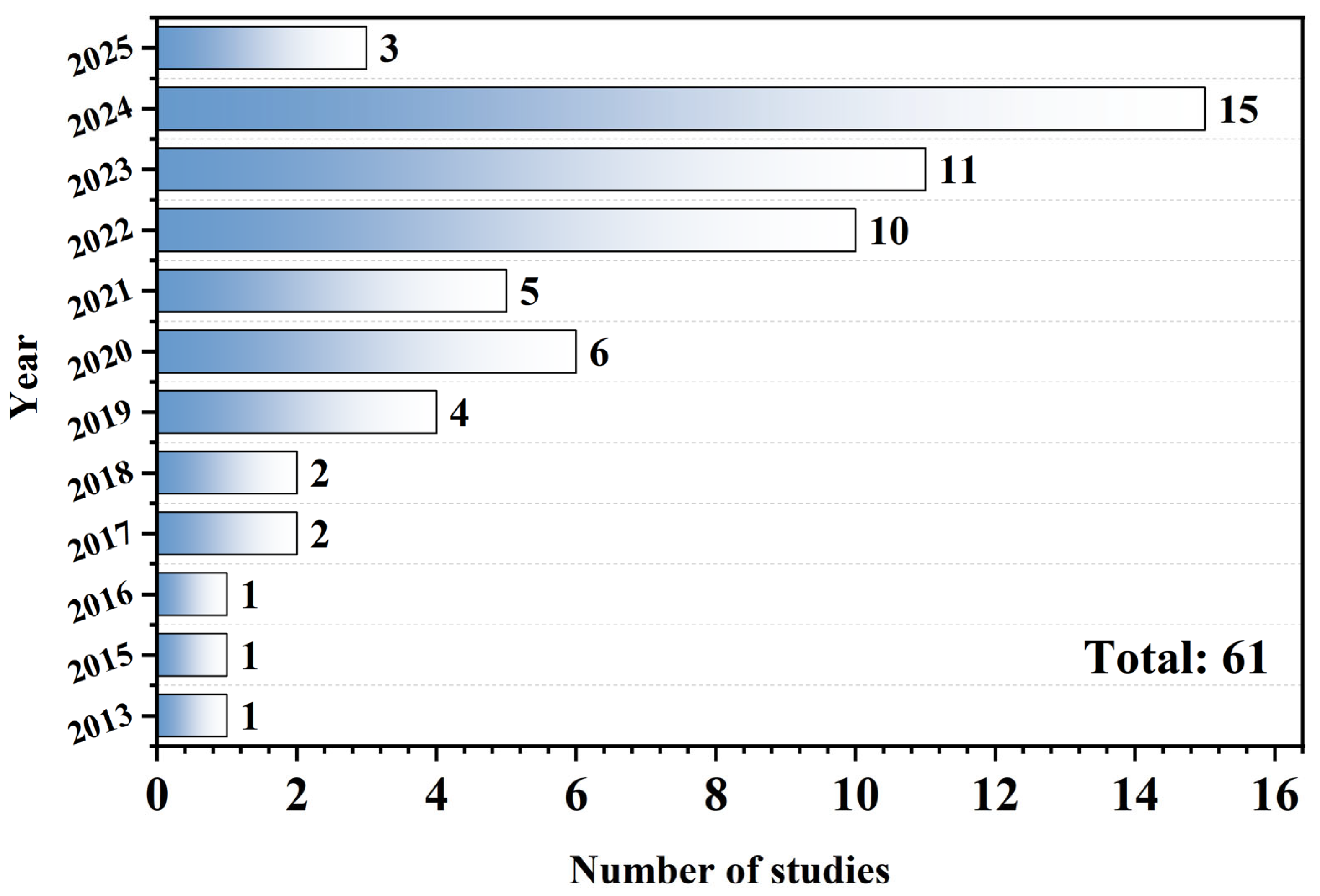

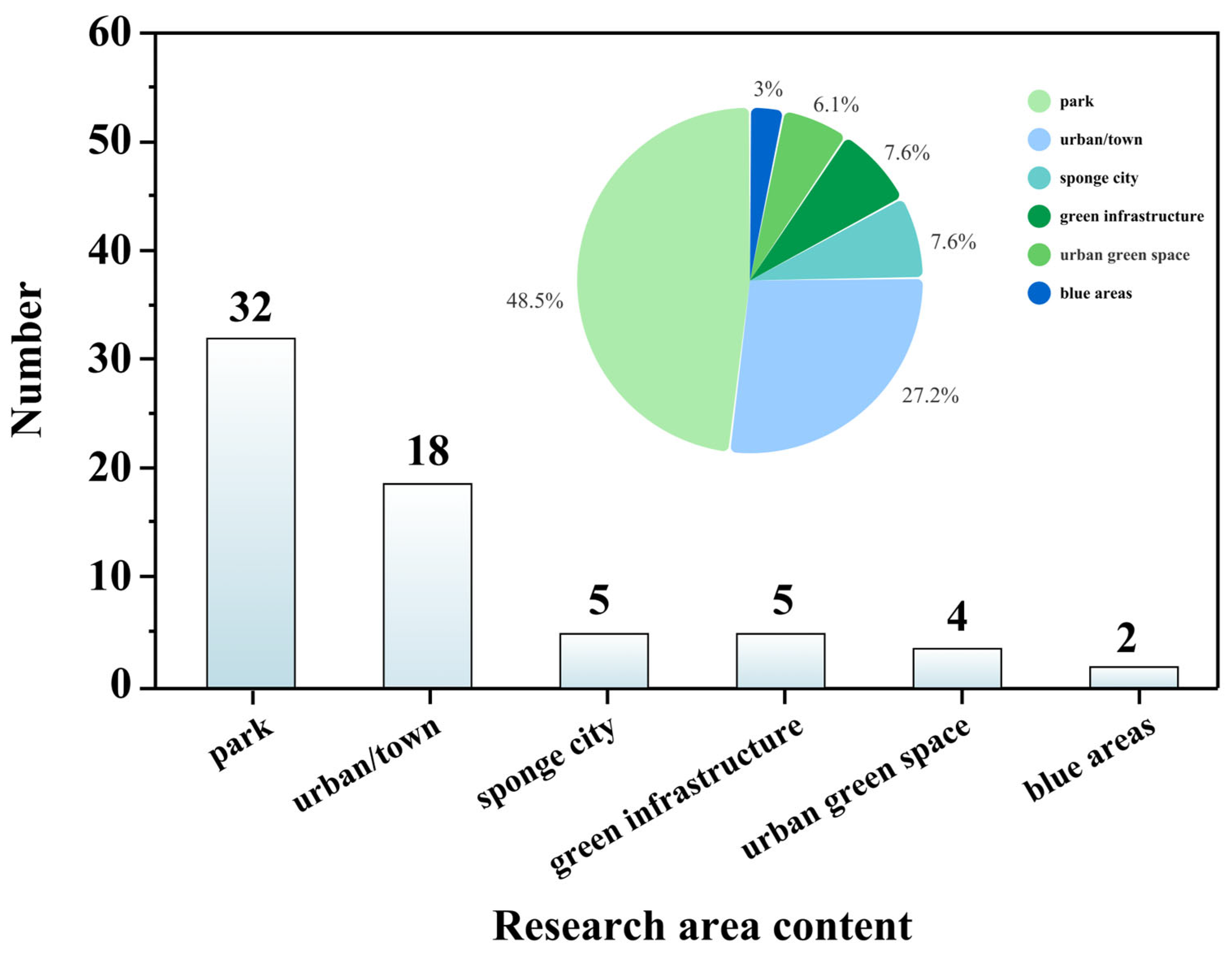
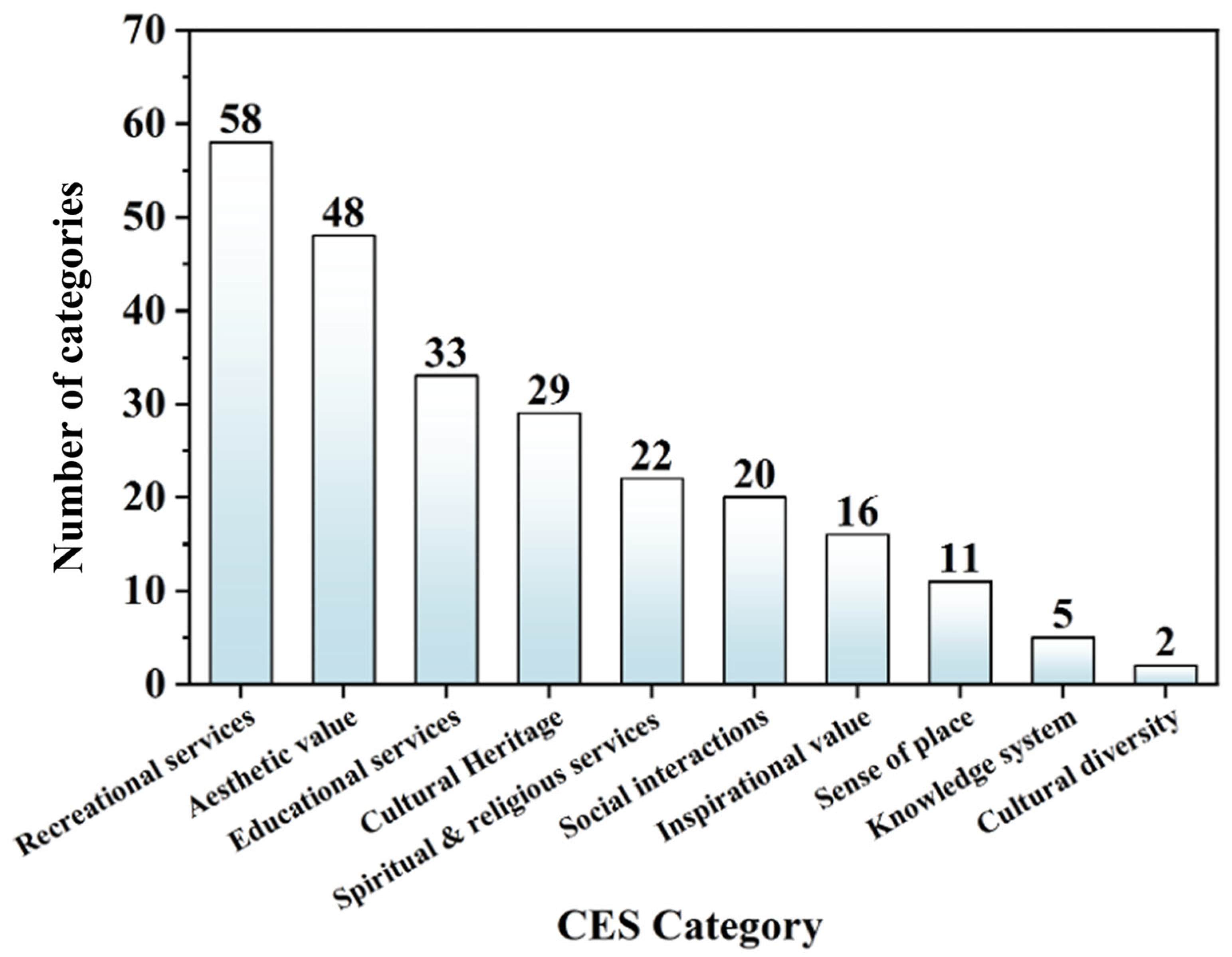
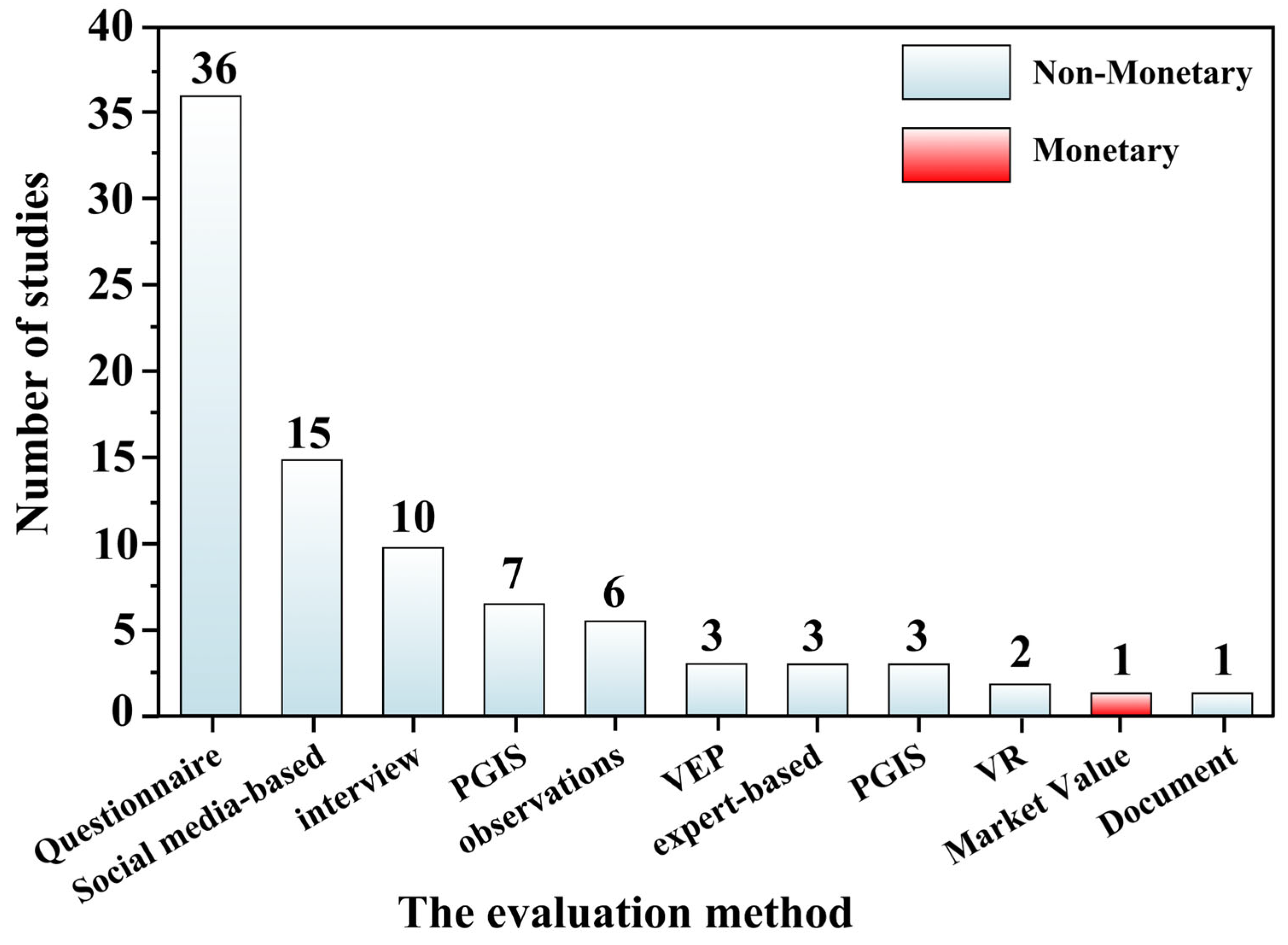


| Category | Concept |
|---|---|
| Cultural diversity | Cultural diversity reflects how the variety of ecosystems contributes to the development of diverse cultures. |
| Spiritual and religious values | Many religions attach spiritual and religious values to ecosystems or their components. |
| Knowledge systems | Ecosystems influence the types of knowledge systems developed by different cultures. |
| Educational values | Ecosystems and their components and processes provide the basis for both formal and informal education in many societies. |
| Inspiration | Ecosystems provide a rich source of inspiration for art, folklore, national symbols, architecture, and advertising. |
| Aesthetic values | Many people find beauty or aesthetic value in various aspects of ecosystems, as reflected in the support for parks, ‘scenic drives,’ and the selection of housing locations. |
| Social relations | Ecosystems influence the types of social relations that are established in cultures. Fishing societies, for example, differ in many respects in their social relations from nomadic herding or agricultural societies. |
| Sense of place | Many people value the ‘sense of place’ that is associated with recognized features of their environment, including aspects of the ecosystem. |
| Cultural heritage values | Many societies place high value on the maintenance of either historically important landscapes (‘cultural landscapes’) or culturally significant species. |
| Recreational values | People often choose where to spend their leisure time based in part on the characteristics of the natural or cultivated landscapes in a particular area. |
| Category | Method | Method Description |
|---|---|---|
| Method Description | Market Prices | Estimates the economic value of CES based on the prices of marketable goods. For example, the entrance fee to a park can be used to approximate the value of recreation and ecotourism. |
| Observation | Directly observes human behaviors and actions to infer the social value of CES. For instance, counting visits to a park can help deduce the importance of recreation in that area. | |
| Document Analysis | Examines texts, images, or other forms of documentation to glean information about human preferences for CES. For example, analyzing the number of photographs taken by the public or featured in advertisements can indicate aesthetic value. | |
| Social Media-Based | Utilizes social media data from various platforms to assess CES. For example, the number of wildlife photographs posted on photo-sharing sites (e.g., Flickr) can serve as a proxy for recreation and ecotourism values. | |
| Stated Preferences | Interviews | Gathers in-depth insights into how and why people value CES through direct, often face-to-face, discussions. Respondents freely express their feelings and thoughts, facilitating a deeper understanding of services such as a sense of place or inspiration. |
| Questionnaires | Uses a series of questions to collect information on CES from respondents. For example, researchers may employ Likert scales, asking participants to select from a given set of CES to reveal their perceived benefits. | |
| Expert-Based | Leverages the specialized knowledge and extensive experience of experts who are familiar with technical terminology and concepts. Experts identify key factors they deem relevant to CES issues. | |
| Participatory GIS (PGIS) | Integrates participatory mapping methods with Geographic Information Systems (GIS), involving stakeholders in spatial data collection and analysis. | |
| Public Participation GIS (PPGIS) | Emphasizes local-level engagement, encouraging knowledge production by communities and non-governmental groups. | |
| Visitor-Employed Photography (VEP) | Involves participants using location-enabled applications to freely photograph specific sites. Participants then evaluate various CES value types depicted in the photographs, enabling the quantification of perceived values [27]. | |
| Virtual Reality (VR) | Employs panoramic VR or immersive virtual environments to create realistic, interactive scenes, allowing participants or subjects to virtually “enter” and experience specific natural or urban settings. |
| Category | Definition | Example Indicators |
|---|---|---|
| Educational values | Sponge cities provide essential material for formal and informal education. | Science education facilities: the presence of educational infrastructure (labs, field classrooms, informational signage); on-site educational activities: organized ecological tours, environmental education programs, and outdoor classrooms; informal learning: casual nature observation by individuals or families. |
| Leisure and entertainment | Sponge cities support opportunities for leisure and recreation. | Sports activities: walking, jogging, playing sports (e.g., football, basketball), swimming, kite flying, square dancing; passive leisure: dog walking, sitting/relaxing, reading, meditation; water-based recreation: crab fishing, boating, angling, feeding fish. |
| Social relations | SPI promotes public social interaction and cohesion. | Social spaces: availability of gathering spots for family and friends; community participation: events or design features encouraging community involvement and cohesion; community activities: frequency of outdoor events (movies, concerts, group camping, etc.). |
| Cultural heritage | Sponge cities help preserve and showcase historical and cultural heritage. | Conservation of relics: protection of historical monuments, buildings, and cultural sites; maintenance of heritage sites: regular upkeep (inspections, restoration) of cultural landmarks; intangible heritage: support for traditional crafts, oral histories, and performing arts. |
| Sense of place | Emotional attachment and identity derived from the uniqueness of SPI sites. | Attachment: residents’ emotional attachment to local SPI features; belonging: the sense of belonging or pride in the sponge city neighborhood; memorability: the degree to which the SPI landscape offers unforgettable experiences or lasting impressions. |
| Aesthetic value | Enjoyment of natural beauty and pleasant surroundings in sponge cities. | Natural scenery: visual appeal of landscapes (water bodies, wetlands, greenery); natural sounds: presence of pleasing sounds (birdsong, flowing water, insect calls); natural scents: occurrence of pleasant natural aromas (flowers, wood, fresh grass). |
| Spiritual and religious | Spiritual fulfillment and religious expression supported by SPI environments. | Physical relaxation: sponge city spaces facilitating stress relief and physical well-being; psychological restoration: opportunities for mental relaxation and recovery; spiritual activities: spaces or elements enabling religious practices or personal contemplation. |
| Inspiration | Stimulus for artistic creation and intellectual inspiration from SPI. | Artistic inspiration: settings inspiring art, photography, music, or design; cultural narratives: inspiration for folklore or local cultural stories; intellectual stimulation: new ideas or learning prompted by the sponge city environment (innovative thinking in daily life). |
Disclaimer/Publisher’s Note: The statements, opinions and data contained in all publications are solely those of the individual author(s) and contributor(s) and not of MDPI and/or the editor(s). MDPI and/or the editor(s) disclaim responsibility for any injury to people or property resulting from any ideas, methods, instructions or products referred to in the content. |
© 2025 by the authors. Licensee MDPI, Basel, Switzerland. This article is an open access article distributed under the terms and conditions of the Creative Commons Attribution (CC BY) license (https://creativecommons.org/licenses/by/4.0/).
Share and Cite
Han, N.; Ibrahim, R.B.; Mat Noor, M.S.B. Assessing Cultural Ecosystem Services in Sponge City Infrastructure: A Systematic Review and Framework Proposal. Sustainability 2025, 17, 5130. https://doi.org/10.3390/su17115130
Han N, Ibrahim RB, Mat Noor MSB. Assessing Cultural Ecosystem Services in Sponge City Infrastructure: A Systematic Review and Framework Proposal. Sustainability. 2025; 17(11):5130. https://doi.org/10.3390/su17115130
Chicago/Turabian StyleHan, Nuan, Roziya Binti Ibrahim, and Mohd Sallehuddin Bin Mat Noor. 2025. "Assessing Cultural Ecosystem Services in Sponge City Infrastructure: A Systematic Review and Framework Proposal" Sustainability 17, no. 11: 5130. https://doi.org/10.3390/su17115130
APA StyleHan, N., Ibrahim, R. B., & Mat Noor, M. S. B. (2025). Assessing Cultural Ecosystem Services in Sponge City Infrastructure: A Systematic Review and Framework Proposal. Sustainability, 17(11), 5130. https://doi.org/10.3390/su17115130









